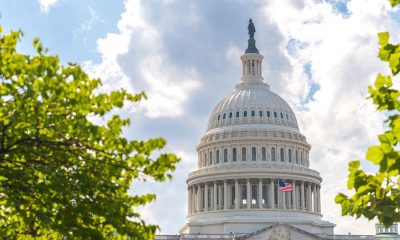#NNPA BlackPress
OP-ED: How heavy a burden does a person of color alleging discrimination have to carry to have his day in court?
NNPA NEWSWIRE — The United States Supreme Court’s decision will determine whether a plaintiff who alleges race discrimination pursuant to 42 USC 1981 may have his or her day in court if he or she can show that racial discrimination was a factor, even among others, in a defendant’s refusal to do business.
By Falen O. Cox, Esq., Founding Partner, Cox, Rodman, and Middleton
The case, Comcast Corp. v. National Association of African American Owned Media and Entertainment Studios Networks, is, on the surface, a case about procedural issues. Beneath the surface it is about the ease or complexity a plaintiff may face when raising claims of racial discrimination under 42 US 1981.
Even though it has reached the United States Supreme Court, procedurally, the lawsuit is in the beginning stages, and the Supreme Court will be deciding whether the plaintiffs (Byron Allen company) may move forward in the legal process to have its “day in court” before a jury, or whether its suit should be dismissed before it reaches a jury or the investigatory process that we lawyers call “discovery.”
During the discovery process each side has an opportunity to ask questions of the other and compel answers, to request documents, and to question potential witnesses. This process is “investigative” and allows the plaintiff to gather the information necessary to present his or her case to a jury, and the defendant the ability to form any defenses he or she may have.
For example, if a plaintiff sues a defendant for rear-ending her at a red light, during the discovery process the plaintiff can ask the defendant whether he was texting at the time of the accident — if he was, the plaintiff can use that to show that the defendant was negligent.
On the other hand, if the plaintiff claims that she has back pain as a result of the collision, the defendant can ask if she has ever had back problems before. If she had been seeing a doctor about back pain prior to the collision, the defendant may be able to show that her back pain was not a result of the collision. However, if the court dismisses a case before the discovery process begins, the case is over, and these “discoveries” are never made.
In short, whether a case makes it to the discovery process, depends on whether the case is allowed to move forward after the plaintiff files a complaint. As common practice, defendants usually file a motion for summary judgement, asking the court to dismiss the plaintiff’s complaint prior to discovery and prior to any decision on the merits of the plaintiff’s claim along with its answer to the plaintiff’s complaint. It is a procedural tactic to prevent the lawsuit from moving further than the written complaint.
There are valid reasons for motions for summary judgement (dismissal). It is designed to make sure that frivolous claims do not overwhelm the court system and to ensure that the court’s limited resources and time are spent on legitimate claims. Additionally, defending a lawsuit can be time consuming and extremely costly for a defendant. A defendant should not have to spend thousands (or in this case probably hundreds of thousands) on legal fees and lost productivity to defend a frivolous claim. The motion for summary judgement acts as a gatekeeper to the legal system.
In this case, the National Association of African-American Owned Media and Entertainment Studios Networks, Inc. (the “Plaintiffs”) filed suit against Comcast, Time-Warner Cable, the former FCC Commissioner, the NAACP, the National Urban League, the National Action Network, and Reverend Al Sharpton alleging that Comcast and the others conspired together to deny it a contract to carry its network/television shows because it is a 100% black-owned company. (Editor’s note: NAN, NUL, and NAACP each are no longer party to the lawsuit).
However, the Court dismissed the suits against everyone except Comcast and Time-Warner for lack of personal jurisdiction, and the plaintiffs abandoned its argument of conspiracy.
At issue now, and before the United States Supreme Court, is whether Comcast, in refusing to contract with the Plaintiff, is in violation of 42 USC 1981. More specifically, whether a plaintiff who alleges discrimination in violation of 42 USC 1981 must allege that racial discrimination was the but for cause of the refusal to contract: “But for the plaintiff’s race, Comcast would have contracted with the plaintiff,” or whether the plaintiff may allege that race was a motivating factor in Comcast’s refusal to contract.
Even though there may have been other reasons that Comcast did not contract with Plaintiffs, the fact that it is a black company was a motivating factor. For context, 42 USC 1981 was enacted in 1886 during Reconstruction (after slavery) and reads:
“All persons within the jurisdiction of the United States shall have the same right in every State and Territory to make and enforce contracts, to sue, be parties, give evidence, and to the full and equal benefit of all laws and proceedings for the security of persons and property as is enjoyed by white citizens, and shall be subject to like punishment, pains, penalties, taxes, licenses, and exactions of every kind, and to no other.”
The District Court, which acts as a trial court in the federal court system, dismissed the Plaintiff’s complaint three times for failure to state a claim for which relief can be granted. It held that the Plaintiff’s complaint failed to show that, but for racial discrimination, Comcast would have contracted with Plaintiff, and that Plaintiff failed to allege that other companies that Comcast did in fact contract with were similarly situated to Plaintiff.
However, Plaintiff appealed the District Court’s decision to the 9th Circuit Court of Appeals which reversed the District Court’s rulings and held that Plaintiff could move forward with its lawsuit. It denied Comcast’s motion for rehearing. Comcast filed a petition for certiorari in the United States Supreme Court, which was granted.
Comcast argues that Plaintiff’s lawsuit should be dismissed because it alleges that Plaintiff’s complaint was insufficient and that it did not allege “but for” causation or refute what Comcast alleges are legitimate business considerations for its refusal to contract with Plaintiff.
Comcast argues that it did not extend a contract to Plaintiff’s as a result of legitimate business practices, e.g.: that it did not have the bandwidth necessary, that it had a preference for sports and news programming, and that there was a lack of demand for Plaintiff’s programming. As a result, Comcast argues that Plaintiffs have failed to show that Comcast would have contracted with them but for Plaintiff’s race.
Comcast points out that it had, within the same time period, considered contracting with ESN; that it had in fact contracted with “Aspire” led by Earvin “Magic” Johnson and Revolt TV led by Sean “Diddy” Combs, which it claims has majority or substantial African-American ownership. Additionally, Comcast alleges that it has carried two 100% black-owned networks, African Channel and Black Family Channel.
Lastly, Comcast argues that Plaintiff’s case should be dismissed because Plaintiff has failed to show that it was similarly situated to the white-owned channels that it did contract with. The reasoning there is that apples must be compared to apples. For instance, if there is a white-owned channel with tremendous interest that is within Comcast’s preferred programming, then the fact that Comcast contracted with that network as opposed to Plaintiff’s — which Comcast alleges does not have interest and is not its preferred programing —is not a result of race discrimination, but instead is Comcast simply choosing the best content for its company.
On the other hand, Plaintiffs allege that it has attempted to contract with Comcast for approximately 8 years and has repeatedly been passed over for white-owned companies despite Comcast’s assurances that its channels were “good enough” and that it was on a “short list.” Additionally, Plaintiff offered its Justice.TV network to Comcast for free and without licensing fees. Comcast declined. As it relates to the lack of bandwidth that Comcast claims is a reason for its refusal to contract, Plaintiff notes that Comcast carries every channel (more than 500) that its competitors carry, except for Plaintiff’s.
Plaintiff’s channels are currently carried on Verizon, FIOS, AT&T, U-Verse, Direct TV, Sudden Link, RCN, Century Link, and many others. Additionally, despite its refusal to contract with Plaintiff as a result of its alleged bandwidth scarcity, Comcast has launched more than 80 lesser known white-owned channels. Plaintiff alleges that during the 8 years that it attempted to contract with Comcast, Comcast directed it to gain field support within the Comcast corporation, once that support had been gained, Plaintiffs were told that field support was no longer a factor.
Next, Plaintiffs were told that it needed Division Support only to be told by the Divisions that it deferred to corporate.
Plaintiffs allege that it spent hundreds of thousands of dollars in marketing and travel to gather support that was deemed necessary, but once achieved, was no longer sufficient.
Most explicit, is Plaintiff’s claim that a Comcast Executive stated, “We’re not trying to create anymore Bob Johnsons.” Bob Johnson is the founder and former owner of B.E.T. which was sold to Viacom for a reported $3 billion.
Plaintiffs allege that Comcast’s refusal to contract, in addition to being motivated by race alone, is also motivated by its desire not to have its networks (and the white-owned networks that it carries) be required to compete with Plaintiff’s networks, which are black-owned.
The United States Supreme Court’s decision will determine whether a plaintiff who alleges race discrimination pursuant to 42 USC 1981 may have his or her day in court if he or she can show that racial discrimination was a factor, even among others, in a defendant’s refusal to do business. If so, the plaintiff will be able to move forward through the legal process — and most importantly, through the discovery process — to investigate his or her claim and obtain the evidence necessary (if it exists) to put the question before a jury.
On the other hand, if the Court rules instead that a plaintiff must allege that, but for racial discrimination, the defendant would have contracted with him or her, a plaintiff looking to have his or her day in court will need much stronger evidence, and will be required to disprove any other reason given by the defendant for its refusal to contract without the benefit of discovery.
For example, if a defendant denies discrimination and instead says that it refused to contract because of limited resources without the benefit of discovery, the plaintiff may never learn that the defendant doubled its spending with white-owned companies within that same time period. To the contrary, this is information that the plaintiff might learn through the discovery process if his or her case is allowed to proceed.
This case, like so many other recent cases, will test the Supreme Court’s interpretation of the strength of civil rights law.
Falen O. Cox is the founding partner and director of operations at the Savannah, Ga.-based law firm of Cox, Rodman and Middleton.
#NNPA BlackPress
LIHEAP Funds Released After Weeks of Delay as States and the District Rush to Protect Households from the Cold
BLACKPRESSUSA NEWSWIRE — The federal government has released $3.6 billion in home heating assistance after a delay that left states preparing for the start of winter without the program’s annual funding.

By Stacy M. Brown
Black Press USA Senior National Correspondent
The federal government has released $3.6 billion in home heating assistance after a delay that left states preparing for the start of winter without the program’s annual funding. The Low-Income Home Energy Assistance Program, known as LIHEAP, helps eligible households pay heating and cooling bills. The release follows a shutdown that stretched 43 days and pushed agencies across the country to warn families of possible disruptions.
State officials in Minnesota, Kansas, New York, and Pennsylvania had already issued alerts that the delay could slow the processing of applications or force families to wait until December for help. In Pennsylvania, more than 300,000 households depend on the program each year. Minnesota officials noted that older adults, young children, and people with disabilities face the highest risk as temperatures fall.
The delay also raised concerns among advocates who track household debt tied to rising utility costs. National Energy Assistance Directors Association Executive Director Mark Wolfe said the funds were “essential and long overdue” and added that high arrearages and increased energy prices have strained families seeking help.
Some states faced additional pressure when other services were affected by the shutdown. According to data reviewed by national energy advocates, roughly 68 percent of LIHEAP households also receive nutrition assistance, and the freeze in multiple programs increased the financial burden on low-income residents. Wolfe said families were placed in “an even more precarious situation than usual” as the shutdown stretched into November.
In Maryland, lawmakers urged the Trump administration to release funds after the state recorded its first cold-related death of the season. The Maryland Department of Health reported that a man in his 30s was found outdoors in Frederick County when temperatures dropped. Last winter, the state documented 75 cold-related deaths, the highest number in five years. Rep Kweisi Mfume joined more than 100 House members calling for immediate federal action and said LIHEAP “is not a luxury” for the 100,000 Maryland households that rely on it. He added that seniors and veterans would be placed at risk if the program remained stalled.
Maryland Gov. Wes Moore used $10.1 million in state funds to keep benefits moving, but noted that states cannot routinely replace federal dollars. His administration said families that rely on medical equipment requiring electricity are particularly vulnerable.
The District of Columbia has already mapped out its FY26 LIHEAP structure in documents filed with the federal government. The District’s plan shows that heating assistance, cooling assistance, weatherization, and year-round crisis assistance operate from October 1 through September 30. The District allocates 50 percent of its LIHEAP funds to heating assistance, 10 percent to cooling, 13 percent to year-round crisis assistance, 15 percent to weatherization, and 10 percent to administrative costs. Two percent is used for services that help residents reduce energy needs, including education on reading utility bills and identifying energy waste.
The District’s plan lists a minimum LIHEAP benefit of $200 and a maximum of $1,800 for both heating and cooling assistance. Crisis benefits are provided separately and may reach up to $500 when needed to resolve an emergency. The plan states that a household is considered in crisis if it has been disconnected from energy service, if heating oil is at 5 percent or less of capacity, or if the household has at least $200 owed after the regular benefit is applied.
The District’s filing notes that LIHEAP staff conduct outreach through community meetings, senior housing sites, Advisory Neighborhood Commissions, social media, posters, and mass mailings. The plan confirms that LIHEAP applicants can apply in person, by mail, by email, or through a mobile-friendly online application and that physically disabled residents may request in-home visits.
As agencies nationwide begin distributing the newly released funds, states continue working through large volumes of applications. Wolfe said LIHEAP administrators “have been notified that the award letters have gone out and the states can begin to draw down the funds.”
#NNPA BlackPress
Seven Steps to Help Your Child Build Meaningful Connections
BLACKPRESSUSA NEWSWIRE — Swinging side by side with a friend on the playground. Sharing chalk over bright, colorful sidewalk drawings. Hiding behind a tree during a spirited game of hide-and-seek. These simple moments between children may seem small, but they matter more than we think

By Niyoka McCoy, Ed.D., Chief Learning Officer, Stride/K12
Swinging side by side with a friend on the playground. Sharing chalk over bright, colorful sidewalk drawings. Hiding behind a tree during a spirited game of hide-and-seek. These simple moments between children may seem small, but they matter more than we think: They lay the foundation for some of life’s most important skills.
Through everyday play, young children begin learning essential social and emotional skills like sharing, resolving conflicts, showing empathy, and managing their emotions. These social skills help shape emotional growth and set kids up for long-term success. Socialization in early childhood isn’t just a “nice-to-have”—it’s essential for development.
Yet today, many young children who haven’t yet started school aren’t getting enough consistent, meaningful interaction with peers. Research shows that there’s a decline in active free play and peer socialization when compared to previous generations.
There are many reasons for this. Children who are home with a parent during the day may spend most of their time with adults, limiting opportunities for peer play. Those in daycare or preschool may have restricted free play, and large classrooms can reduce supervision and social coaching. Some children live in rural areas, are homebound due to illness, have full schedules, or rely on screens to fill their playtime. And for some families, finding other families with young children to connect with isn’t easy.
While these challenges can feel significant, opportunities for connection still exist in every community. Families can take simple steps to help children build friendships, create a sense of belonging, and strengthen social skills. Here are some ideas to get started:
- Storytime sessions at libraries or local bookstores
- Community offerings such as parent-child workshops, art, music, gymnastics, swimming, or sports programs
- Weekly events at children’s museums, which may include art projects, music workshops, or science experiments
- Outdoor exploration, where kids can play with peers
- Local parenting groups that organize playdates and group activities
- Volunteer opportunities where children can participate, such as pet adoption events or packing meals at a food bank
- Classes for kids at local businesses, including hardware, grocery, or craft stores
Some of these community activities are free or low-cost and give kids the chance to build friendships and practice social skills. Parents can also model positive social behavior by interacting with other parents and encouraging their children to play with their peers.
These may seem like small moments of connection, but they can have a powerful impact. Every time your child shares a toy, plays make-believe with peers, or races a friend down the slide, they’re not just playing—they’re learning the skills that build confidence, empathy, and lasting friendships. And it’s good for you, too. Creating intentional opportunities for play also helps you strengthen your own network of parents who can support one another as your children grow together.
#NNPA BlackPress
Seven Steps to Help Your Child Build Meaningful Connections
BLACKPRESSUSA NEWSWIRE — Swinging side by side with a friend on the playground. Sharing chalk over bright, colorful sidewalk drawings. Hiding behind a tree during a spirited game of hide-and-seek. These simple moments between children may seem small, but they matter more than we think

By Niyoka McCoy, Ed.D., Chief Learning Officer, Stride/K12
Swinging side by side with a friend on the playground. Sharing chalk over bright, colorful sidewalk drawings. Hiding behind a tree during a spirited game of hide-and-seek. These simple moments between children may seem small, but they matter more than we think: They lay the foundation for some of life’s most important skills.
Through everyday play, young children begin learning essential social and emotional skills like sharing, resolving conflicts, showing empathy, and managing their emotions. These social skills help shape emotional growth and set kids up for long-term success. Socialization in early childhood isn’t just a “nice-to-have”—it’s essential for development.
Yet today, many young children who haven’t yet started school aren’t getting enough consistent, meaningful interaction with peers. Research shows that there’s a decline in active free play and peer socialization when compared to previous generations.
There are many reasons for this. Children who are home with a parent during the day may spend most of their time with adults, limiting opportunities for peer play. Those in daycare or preschool may have restricted free play, and large classrooms can reduce supervision and social coaching. Some children live in rural areas, are homebound due to illness, have full schedules, or rely on screens to fill their playtime. And for some families, finding other families with young children to connect with isn’t easy.
While these challenges can feel significant, opportunities for connection still exist in every community. Families can take simple steps to help children build friendships, create a sense of belonging, and strengthen social skills. Here are some ideas to get started:
- Storytime sessions at libraries or local bookstores
- Community offerings such as parent-child workshops, art, music, gymnastics, swimming, or sports programs
- Weekly events at children’s museums, which may include art projects, music workshops, or science experiments
- Outdoor exploration, where kids can play with peers
- Local parenting groups that organize playdates and group activities
- Volunteer opportunities where children can participate, such as pet adoption events or packing meals at a food bank
- Classes for kids at local businesses, including hardware, grocery, or craft stores
Some of these community activities are free or low-cost and give kids the chance to build friendships and practice social skills. Parents can also model positive social behavior by interacting with other parents and encouraging their children to play with their peers.
These may seem like small moments of connection, but they can have a powerful impact. Every time your child shares a toy, plays make-believe with peers, or races a friend down the slide, they’re not just playing—they’re learning the skills that build confidence, empathy, and lasting friendships. And it’s good for you, too. Creating intentional opportunities for play also helps you strengthen your own network of parents who can support one another as your children grow together.
-

 Activism3 weeks ago
Activism3 weeks agoOakland Post: Week of November 12 – 18, 2025
-

 Activism4 weeks ago
Activism4 weeks agoOakland Post: Week of November 5 – 11, 2025
-

 Activism2 weeks ago
Activism2 weeks agoIN MEMORIAM: William ‘Bill’ Patterson, 94
-

 Activism3 weeks ago
Activism3 weeks agoHow Charles R. Drew University Navigated More Than $20 Million in Fed Cuts – Still Prioritizing Students and Community Health
-

 #NNPA BlackPress3 weeks ago
#NNPA BlackPress3 weeks agoThe Perfumed Hand of Hypocrisy: Trump Hosted Former Terror Suspect While America Condemns a Muslim Mayor
-

 Bay Area3 weeks ago
Bay Area3 weeks agoNo Justice in the Justice System
-

 #NNPA BlackPress3 weeks ago
#NNPA BlackPress3 weeks agoProtecting Pedophiles: The GOP’s Warped Crusade Against Its Own Lies
-

 #NNPA BlackPress2 weeks ago
#NNPA BlackPress2 weeks agoTrump’s Death Threat Rhetoric Sends Nation into Crisis

























































